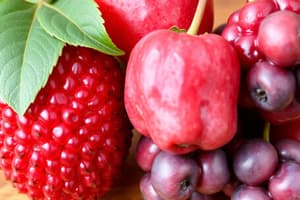Podcast
Questions and Answers
What factors significantly influence the nutrient content in fruits?
What factors significantly influence the nutrient content in fruits?
- Storage duration after harvest
- Local climate and soil type
- Variety and ripeness of the fruit (correct)
- Transportation methods used
Which fruits are noted for their high antioxidant content?
Which fruits are noted for their high antioxidant content?
- Berries (correct)
- Bananas
- Grapes
- Apples
What is a benefit of maintaining a healthy diet rich in fruits and vegetables?
What is a benefit of maintaining a healthy diet rich in fruits and vegetables?
- Improved glycemic index
- Increased protein intake
- Higher calorie consumption
- Reduced risk of certain diseases (correct)
Which practice can help minimize the environmental impacts of fruit cultivation?
Which practice can help minimize the environmental impacts of fruit cultivation?
What is one of the key sustainable practices that can positively impact the fruit industry?
What is one of the key sustainable practices that can positively impact the fruit industry?
What is one primary function of fruits in flowering plants?
What is one primary function of fruits in flowering plants?
Which dietary benefits are commonly attributed to consuming fruits?
Which dietary benefits are commonly attributed to consuming fruits?
What technique is used to enhance fruit production and quality in cultivation?
What technique is used to enhance fruit production and quality in cultivation?
Which option describes a factor in the successful storage of fruits?
Which option describes a factor in the successful storage of fruits?
Which type of fruit is developed from a flower with multiple ovaries?
Which type of fruit is developed from a flower with multiple ovaries?
What is one of the economic impacts of fruit production?
What is one of the economic impacts of fruit production?
Which nutrient is not commonly found in fruits?
Which nutrient is not commonly found in fruits?
What is one consequence of improper post-harvest handling of fruits?
What is one consequence of improper post-harvest handling of fruits?
Flashcards
What are fruits?
What are fruits?
Fruits are the mature ovaries of flowering plants that develop after fertilization, enclosing and protecting seeds.
Name some types of fruits.
Name some types of fruits.
Berries, drupes, pomes, and legumes are all different types of fruits.
What nutrients do fruits provide?
What nutrients do fruits provide?
Fruits provide vital nutrients, including vitamins, minerals, and antioxidants.
How do fruits benefit our health?
How do fruits benefit our health?
Signup and view all the flashcards
What are the long-term benefits of eating fruits?
What are the long-term benefits of eating fruits?
Signup and view all the flashcards
Why is proper fruit harvesting important?
Why is proper fruit harvesting important?
Signup and view all the flashcards
How do you store fruits to keep them fresh?
How do you store fruits to keep them fresh?
Signup and view all the flashcards
What factors impact fruit cultivation?
What factors impact fruit cultivation?
Signup and view all the flashcards
Fruit Nutrient Variation
Fruit Nutrient Variation
Signup and view all the flashcards
Vitamin C in Citrus Fruits
Vitamin C in Citrus Fruits
Signup and view all the flashcards
Antioxidants in Berries
Antioxidants in Berries
Signup and view all the flashcards
Fruits and Disease Prevention
Fruits and Disease Prevention
Signup and view all the flashcards
Environmental Impact of Fruit Farming
Environmental Impact of Fruit Farming
Signup and view all the flashcards
Study Notes
Types of Fruits
- Fruits are the mature ovaries of flowering plants, developing after fertilization.
- They enclose and protect seeds.
- Fruits are classified based on their development, texture, and structure.
- Some fruits form from a single flower, while others develop from multiple flowers.
- Examples of fruit types include berries, drupes, pomes, and legumes.
Structure and Function
- Fruits contain a variety of nutrients, including carbohydrates, vitamins, and minerals.
- They contribute essential vitamins, minerals, and dietary fiber to human diets.
- The fruit's edible portion is often derived from different parts of the flower, such as the ovary, receptacle, or other floral parts.
Benefits of a Fruit-Based Diet
- Fruits supply vital nutrients, including vitamins (e.g., vitamin C, vitamin A), minerals, and antioxidants.
- High dietary fiber content in fruits contributes to digestive health and can aid in weight management.
- They play a role in reducing the risk of chronic diseases, such as cardiovascular disease and certain cancers.
- Fruits can also reduce cholesterol levels and promote healthy blood sugar control.
Harvesting and Storage
- Fruits require careful harvesting techniques to avoid damage and ensure proper transportation.
- Proper storage conditions, including temperature and humidity, are crucial to maintain quality and prevent spoilage.
- Different fruits have different optimal storage conditions, and incorrect handling can affect their taste, texture, and nutritional value.
- Post-harvest handling impacts the shelf life of the fruits and their overall quality.
Cultivating Fruits
- Fruit cultivation involves careful selection of suitable climates, soil types, and irrigation methods.
- Different fruits require specific growing conditions for optimal yield.
- Cultivators use various techniques such as grafting and pruning to enhance fruit production and quality.
- Proper plant care, including fertilization, pest control, and disease management, is essential for successful cultivation.
Economic Importance
- Fruits are a major agricultural commodity worldwide.
- Global agricultural practices vary based on climate and preferences.
- Fruit production supports livelihoods in many communities and regions through employment and income generation.
Nutritional Composition
- Fruits vary in their nutritional profiles.
- The nutrient content (e.g., vitamins, minerals, antioxidants) depends on the variety and ripeness of the fruit.
- Fruits have varying levels of sugars, fiber, and water.
Health Implications
- Some fruits, like citrus fruits, are rich in vitamin C.
- Fruits like berries are abundant with antioxidants.
- Maintaining a healthy diet with fruits and vegetables can contribute to a reduced risk of certain diseases.
- Fruits provide various essential micronutrients.
Environmental Impact
- Fruit cultivation can have environmental impacts, including land use and water usage.
- Sustainable agricultural practices are important to minimize environmental footprint.
- Practices like soil conservation and water management can minimize negative effects.
- Using sustainable transportation methods and reducing food waste can also positively impact the fruit industry.
Studying That Suits You
Use AI to generate personalized quizzes and flashcards to suit your learning preferences.




